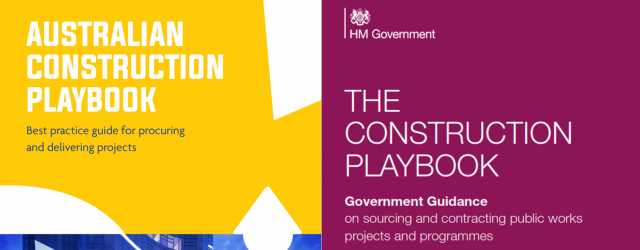The Case for an Australian Construction Playbook
Posted: 22nd April 2021
Posted in: Blog

Posted: 22nd April 2021
Posted in: Blog
Across the globe, governments are relying heavily on the construction industry to help rebuild their economies through investment in the construction of new infrastructure, but the system used to procure and deliver these projects is fundamentally broken.
Project cost and time over-runs are commonplace. In Australia, construction productivity growth over the last thirty years trails that of other significant industries by 25 per cent. Women make up only 12 per cent of the construction workforce and construction workers are 6 times more likely to die from suicide than a workplace incident.
The construction sector, Australia’s third largest industry—employing 10 per cent of the working population, accounted for 20 per cent of all insolvencies last financial year.
This narrative needs to change, not just for the sake of the industry but for the sake of the entire Australian economy.
If we could just halve the gap in productivity growth between the construction industry and other industries over the past 30 years, we could construct an extra $15 billion of infrastructure every year for the same level of expenditure and employ an extra 15,000 people.
Now is the time to act. Not in 12, 18, 24 months’ time when the planned investment is being realised in concrete, steel and asphalt.
Now is the time to set the industry on a more sustainable path, to create a forward-looking industry focused on the next decade rather than the next project. Now is the time to create a productive industry that embraces new technology and new ways of doing things and is a diverse industry of choice for the next generation of the workforce looking for a safe, challenging and rewarding career.
But how do we bring about change to a deep-rooted industry where all previous attempts have failed to make a significant impact?
The problems of the industry are well understood—there are many government / private sector studies and initiatives largely agreeing on what needs to be done. What is lacking is a way to bring this all together in a coherent way so that all levels and government and industry can act with purpose and in unison.
We believe a Construction Playbook, like that just published in the UK, is the answer.
Whether your perspective is from project management, design, procurement, commercial or other, the Construction Playbook is relevant to the entire construction industry. It is a great example of what can be achieved when government and industry work together with a common purpose.
What is a playbook?
The UK Construction Playbook is a ‘compact’ between government and industry that sets out how the two will work together. It captures industry best practices and specific sector reforms. Moreover, it outlines the government’s expectations of how contracting agencies and suppliers, including the supply chain, should engage with each other.
Whilst generally considered as a best practice guide, key policies are mandated on a ‘comply or explain’ basis. At a high level, these include continuous improvement in building and workplace safety, cost, speed and quality of delivery, greater sharing of better data, investment in training the future workforce through upskilling and apprenticeships, and adoption of the UK BIM Framework.
Below are the 14 policies described in the playbook, all of which are relevant in the Australian context:
Genesis of the UK Construction Playbook
The familiar tale of boom and bust, of blowouts and litigation and of collapses and company failures led to the development of the UK Construction Playbook.
In 2018, following the massive implications after the collapse of Carillion, the UK Government committed to working with industry to develop an Outsourcing Playbook to improve the way that the UK Government worked with private companies when outsourcing government services. The Playbook[1], that was published in February 2019, was a great success and the UK Government turned its mind to developing a similar Playbook for the construction industry.
The UK Government reached out to the Construction Leadership Council (CLC)—a body that collectively represents UK construction industry associations—to work with it on the development of a Construction Playbook.
The development of the Construction Playbook commenced before the outbreak of COVID-19 and was significantly accelerated as a result of the pandemic as all sides saw that the Playbook could help the industry better respond. The transition to virtual meetings also made it easier for all parties to meet frequently to review drafting with the task of drafting being assigned to the government.
The Construction Playbook was finalised in less than a year and published in December 2020[2].
The Australian context
In Australia, the Federal Government funds the majority of the cost of all infrastructure through arrangements such as the National Partnership Agreement, but the states are ultimately responsible for procurement and delivery.
As the Federal Government places very few preconditions on how this money is spent, industry efforts have focused on convincing the state delivery agencies of the need for reform. Whilst the Australian Constructors Association has facilitated a coordinated reform agenda through the Construction Industry Leadership Forum in partnership with the Victorian and NSW Governments, there is no national agreement on the need, type and pace of reform. Without coordinated action, it could take many years to achieve significant and lasting improvements.
A way forward
As the bankroller of infrastructure in Australia, the Federal Government is best placed to drive reform of the construction industry through the development of a Construction Playbook. It also has much to gain from doing so. It can create extra jobs, build more for less, drive innovation, improve worker wellbeing and increase industry diversity.
If we had a Construction Playbook:
So, what are we waiting for?
It’s time for an Australian Construction Playbook!
[1] https://www.gov.uk/government/news/updated-outsourcing-playbook
[2] https://www.gov.uk/government/publications/the-construction-playbook